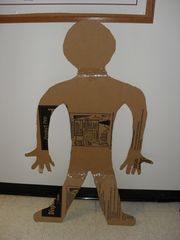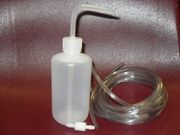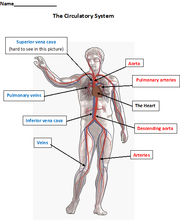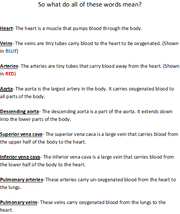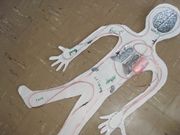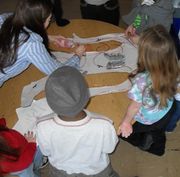My hard-working heart
| Students @ Work - a student collaborative writing project. Help us by providing feedback on the Discussion page. |
| Instant wiki maker | Making handouts | Editing tips |
Contents
Biology In Elementary Schools is a Saint Michael's College student project from a course that ran between 2007 and 2010 and fully described in this book chapter. The student-created resources have been preserved here for posterity. Link under 'toolbox' for printer-friendly versions of the exercises. Click on handouts to print full resolution versions. Please see Wikieducator's disclaimer, our safety statement, and the Creative Commons licensing in English and in legalese.
Student worthiness
Before this experiment was tested in a classroom with students, it was built and tested to make sure that all of our tubing and connections worked. Since then, this experiment was brought in front of students and six circulatory systems where built. Students really found this experiment interesting because it gives the students a general idea of how the circulatory system works.
Primary biological content area covered
Learning about the human body is a great way for students to understand what is going on in their own body. The circulatory system, one of the most important systems in our body, is a topic that students find interesting as well as it is very important for students to learn about one of the systems that keeps us alive. After completing this activity, students will understand the different parts of the circulatory system as well as how it works. Students will be able to explore the circulatory system in depth as they construct their own system.
Materials
- Sample Heart (To show the students what a real heart looks like.)
- Water Bottles
- Check Valves
- Aquarium Glue
- Drill
- Tape
- Tubing
- Water
- Red Food Coloring
- Markers
- Cardboard
- Barbed T-joints (If you are using lots of little pieces of tubing rather than one long one.)
- Scissors
- Exacto-knife
How to make the heart:
Take a water bottle and remove the lid. Flip the water bottle upside down and drill a hole in the bottom. Then take a check valve and stick in the bottom of the water bottle so when the water bottle pumps water out the bottom. Place the lid back on the water bottle and squeeze the water bottle to see if it works. (Make sure there is pressure on the opposite side, otherwise the water will not come out the other side.) If the water does not come out the bottom, the check valve maybe upside down. If this is the case simply pull the check valve out and flip it.
Handouts
- A labeled diagram of the human circulatory system (shown below)
- A sheet with definitions of the words used in the diagram (shown below)
Description of activity
Students will gain a better understanding of how the circulatory system operates through constructing their own circulatory system. The students will accomplish this task by taking a cardboard cut out of a person, tubing, and a makeshift water bottle pump heart to construct there own system. As the students follow a labeled diagram to help them build the system, they will tape the tubing and pump to the board. This activity will help students recognize the different parts of the circulatory system as well as how it works.
Lesson plan
Topic of Lesson: The Circulatory System
Age/Grade: Second and Third Graders
Essential Question: How does our circulatory system work?
Learning Activity:
- I will ask the class "What do you think we be learning about today? Why do you think it is important for us to learn about the circulatory system?”
- Next, I will explain to the students that the circulatory system is a complex system made up of muscles, veins, arteries and blood that help circulate oxygen around the body. I will continue by telling them that the heart is one of the most important organs in our bodies that keeps us alive. The heart pumps blood through our veins and arteries all around the body bringing oxygen to our muscles, lungs, kidneys and most importantly the brain. I will continue to explain to the students that our heart is made out of four compartments that help circulate the blood around the body. These four compartments help control the bloods movements around the body. These compartments are know was the left and right ventricles and the left and right atriums. During my explanation of the heart, I will show them a heart and point to where each of the compartments are located.
- I will then hand the students a list of the following vocabulary words (definitions can be found on the handout): Heart, Veins, Arteries, Aorta, Descending aorta, Superior vena cava, Inferior vena cava, Pulmonary arteries, and Pulmonary veins.
- Next, I will give the students the handout so they can picture what the system looks like.
- After giving the students a brief explination of the circulatory system and the hand out, I will tell the students will be making their own circulatory system with my guidance. I will tell the students they are to use the labeled materials on the table to construct their own circulatory system. I will also let them know that they will be building this together as a group and they can use their handout for guidance. The students will spend the remaining time on constructing their own circulatory system as a group.
- The students will then begin to build the circulatory system with assistance from us. They will attach the tubing and heart (Made from a water bottle and check valve. Be sure to see materials on how to build the heart.) to a cut out of a human body. The tubing should extend into all of the limbs, brain, lungs and kidneys and the brain.
- After the students have finished constructing their own circulatory system, I will then pour water (colored red) and pump the water through the tubes showing them how the system works. If their is time left each student will get a chance to squeeze the water bottle pumping the blood through the body.
- The students will clean up their area and also will get to hang their work up on the wall.
Pitfalls
Some possible problems with this activity are:
- With some of the groups we ran tight on time and were not able to take our time in completing this activity. I found it hard to judge ahead of time how much we would actually be able to accomplish during the given twenty minutes that we had to complete the activity with each group.
- Students might might have been turned off by some of the big vocabulary that we used. Even though we tried to present everything at an age-appropriate (second and third grade) level, some of the parts of the circulatory system have big names, but are too essential to the lesson for us not to talk about them and/or include them in the handouts. (Such as the superior and inferior vena cava or the pulmonary arteries.)
- With other groups of students doing different activities in the same room as us, it was hard to keep the students in our group focused on our activity.
- It was hard to get the students to work together and not fight over who got to do what. In general it was hard to get the students to listen to us, because we didn't know them and they didn't know us, and the were a bit out of control.
Math connections
Does the activity link in any way to grade-appropriate math skills?
Literature/Musical connections
The children will be able to make a musical connection by doing this project by working with the song "Keep the Beat" from My Bodyworks by Jane Schoenberg. We plan to play the song while making the project with the children, and give them a copy of the lyrics.
KEEP THE BEAT
Your heart never rests.
It continues to beat,
Sending blood to your head and your arms and your feet.
You can feel as it pumps
In your left upper chest,
Keeping you healthy so you do your best.
(Chorus)
Your heart is at work when you play,
It never stops beating all through the day.
And even at night when you sleep,
Your heart's on the job keeping up with the beat-
With the beat!
Sometimes when you run,
You can feel your heart pound.
But, often, you don't even know it's around.
It's a muscle that's strong,
But you should exercise
To keep your heart healthy so you'll stay alive.
(Chorus)
Your heart never rests.
It continues to beat,
Sending blood to your head and your arms and your feet.
You can feel as it pumps
In your left upper chest,
Keeping your healthy so you do your best.
(Chorus)
Connections to educational standards
Body Systems S3-4:41 Students demonstrate their understanding of Human Body Systems by...
- Showing connections between external and internal body structures and how they help humans survive,
Science Concepts:
- There are external and internal structures that provide for the survival needs of human organisms.
- Skin protects the body from harmful substances and other organisms and from drying out.
- The skeletal system provides shape and protection for the body’s organs.
- The brain gets/gives signals from/to all parts of the body “telling” the body what to do.
- From food, people obtain nutrients and other materials for body repair and growth. The un-digestible parts of food are eliminated. Key structures are mouth, esophagus, stomach, intestine and anus.
- By breathing, people take in the oxygen that they need to live. Key structure is the lung.
Musical Concepts:
- A1-2:5 Students PERFORM/ COMMUNICATE through music by…
- Singing alone and in unison, using developmentally appropriate repertoire in rhythm, maintaining a steady beat.
- Playing instruments, alone and with others, using developmentally appropriate literature and instruments, in rhythm, maintaining a steady beat.
Next steps
From here, students could learn more in depth about the circulatory system, by learning, for example, what happens to our heart when we exercise, or what is actually happening inside of our bodies when we feel "anxious" or "nervous". (When our blood pressure increases) Teachers could also branch off into learning about the other major organ systems and how they all work together to keep our bodies alive, healthy, and functioning properly.
After making our working models of the circulatory systems we could emphasis the importance of having a healthy heart. We could tie in topics such as nutrition and exercise, telling the children how healthy and unhealthy habits will effect their hearts and survival. They will be able to make the connection to how an unhealthy heart will slow down their blood flow.
Dual circuit
An even more realistic version could be made with 2 wash bottles taped together. One bottle (left ventricle) would pump to the body and back to a second bottle (right ventricle). The second bottle would pump to the lungs and back to the first. A loose plastic bag could wrap the points where fluids enter each bottle to symbolize the atria and you'd have a 4-chamber heart.
Reflections
After having been into the school and taught the lesson to the students, I think that it went pretty well overall, but there was definitely room for improvement. The first group of students that we did our activity with were complete chaos, and part of that I think was because of that particular group of students, but part of that was also us and the fact that we were not as prepared as we could have been. We should have discussed ahead of time what we were going to tell the students to begin our lesson/activity on the circulatory system. And we should have practiced explaining the system in second/third grade friendly terms before we had to actually do it for the students.
If I were actually to do this activity with the students in my class someday, then I think I would incorporate an artistic aspect into it as well. Instead of having the cardboard people pre-cut and ready for the students, I would have the students trace their own bodies, cut them out, and draw the major organs that make up the circulatory system themselves with whatever art supplies we would have in the classroom.
In my opinion, I think that this project went very well. For the amount of preparation time that we had, and never having really taught in a classroom setting before, I think we were successful. The children learned a lot about the circulatory system by having the opportunity to be hands-on. A student teacher commented to me that our project was very effective with the children because it was not to complex, and it kept them engaged. The kids were all very excited about getting to make the heart pump and seeing the 'blood' actually travel around the body.
Even though I consider our project an overall success, there are definitely areas that could be improved. The children were at times a little out of control when working with the materials. For example, they yanked the tubing out of each others hands, and pushed on the 'heart' too hard. Before starting construction, we should have set guidelines for the children such as telling them to be gentle. Most of our problems came from the children not listening and being out of control, which would have been prevented if we knew the children better and had a better working relationship with them. Something else that could have been improved upon was our preparedness. We could have discussed more what we were going to say to the children and who was going to say what, which would have relieved some of the stress of the situation.
If I were to do this activity in my classroom in the future, I would have a bigger area to work which would allow the children to not be so crowded, and it would make it easier for them to take turns building the body. Also, I would have the children be more involved in preparing the project, such as making the bodies and drawing the organs. I would also have the children do a follow up activity such as a writing assignment or a worksheet to help reinforce what they learned.
After being in the classroom with the students, I feel the project went pretty well overall. However, I think we could have delivered the information a little better because after the first two groups, I feel the students had heard about what they would be doing at our station and really didn’t focus on what we where trying to tell them about the circulatory system. If we were going to do this project again, as a group we should discuss a different away of approaching the introduction to the project. For example, we should not have laid the cardboard person on the table in front of them because I feel like they were distracted by the activity that we would be doing. We should have laid the poster out in front of them and talked about the information we wanted them to know first and then lay the cardboard person out in front of them. I feel like we felt pressed for time because our project was very hands on and we knew that is experiment would take second and third graders a lot of time to build so our goal was to leave enough time for them to do the activity. However, despite our troubles with time everything went well the tubing all worked and the students loved the hands on activity.
If I were to do this project in my own classroom, I would have the students look up background information on the circulatory system before doing this activity. I would pick kid friendly websites that the students could easily understand and get the information that I would want them to know. Then as a class or two larger groups do this activity because it is hard for students in second and third grade two work in smaller groups without someone in the group helping them and with this particular activity, students need assistance with this project.
--Khagensmc 21:52, 11 February 2010 (UTC)
Citations and links
Schoenberg, Jane, and Steven Schoenberg. My Bodyworks. Illus. Cynthia Fisher. Northhampton: Interlink Publishing Group, Inc., 2005. N. pag. Print.
http://www.cyh.com/HealthTopics/HealthTopicDetailsKids.aspx?p=335&np=152&id=1446
http://library.thinkquest.org/5777/cir1.htm
http://hes.ucfsd.org/gclaypo/circulatorysys.html#What%20is%20the%20job%20of%20the%20Circulat
http://hes.ucfsd.org/gclaypo/circulatorysys.html#What%20is%20the%20job%20of%20the%20Circulat
http://www.wcs.edu/hbes/student%20websites/circulatory/Circulatory%20Fun%20Facts.html
Common mistakes
This section is strictly for editorial suggestions and will not be part of your final product. The most common editorial suggestions I make are listed here.
| Work in progress, expect frequent changes. Help and feedback is welcome. See discussion page. |

